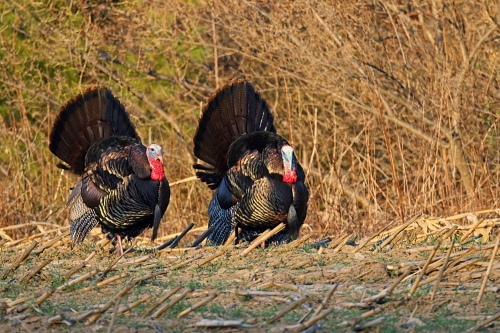Press Releases

04/10/2018
2018 Spring Wild Turkey Hunting Season Opens April 25
Connecticut’s Department of Energy and Environmental Protection (DEEP) is reminding hunters that the 2018 Connecticut spring wild turkey hunting season runs from April 25 through May 26.
Spring Turkey Junior Hunter Training Days will be held on state and private land from Saturday, April 14 through Saturday, April 21 (excluding Sunday, April 15). On these days, licensed junior hunters (12 to 15 years of age) may hunt turkeys when accompanied by a licensed adult hunter 18 years of age or older who must remain within physical contact and in a position to provide direct supervision and instruction. Training days provide junior hunters with an opportunity to learn safe and effective hunting practices from experienced hunters.
“In addition to longer and warmer days, spring brings a special treat for many Connecticut hunters – turkey hunting. Our mixed hardwood forests and adjacent agricultural lands offer ideal habitat and plentiful forage, which in combination provide for some of the finest turkey hunting in New England,” said Michael Gregonis, Wild Turkey Program Biologist for the DEEP Wildlife Division.
During the 2018 spring season, two bearded turkeys may be taken on state land and three on private land. Hunting is permitted from one-half hour before sunrise until noon each day.
This year will mark the 38th consecutive year that sportsmen have hunted turkeys in Connecticut. Healthy and numerous wild turkey populations exist throughout the majority of Connecticut’s woodlands. During the 2017 spring turkey season, hunters took 1,584 bearded turkeys.
Recommended safety precautions for spring turkey hunting:
- Become familiar with two or more areas to hunt, so if someone is already hunting in one of those areas, you can move to another site.
- If another hunter is encountered in the woods, remain still and speak in a loud clear voice to announce your presence.
- Eliminate the colors red, white, and blue from your hunting outfit. These colors are associated with a gobbler’s head and could be mistaken as a turkey.
- Hunters must be sure of their target and what is beyond it, prior to taking a shot.
“Spring turkey hunting requires preparation, patience, and persistence to help maintain a safe hunting experience and the opportunity to harvest a gobbler,” added Michael Gregonis. “Scouting, calling, and hunting techniques unique to this effort can be learned by attending seminars, reading articles, watching videos, and talking with experienced turkey hunters.”
Additional Information
Resident Game Bird Conservation Stamp: Hunters are reminded that spring turkey permits for state and private land have been replaced by the Connecticut Resident Game Bird Conservation Stamp. This $28 stamp ($14 for resident 12- to 17-year-olds) is valid for the calendar year and is required for hunting wild turkey, pheasant, chukar and Hungarian partridges, grouse, and quail. Stamps can be purchased online (www.ct.gov/deep/sportsmenlicensing) or over the counter at some DEEP offices, town clerk offices, and commercial vendors that sell hunting, fishing, and outdoor equipment. All revenue from the sale of Resident Game Bird Conservation Stamps is deposited into a separate, non-lapsing account to use exclusively for the purchase and management of game birds and their habitat.
Turkey hunters who hunt on private land are reminded that written landowner permission, on a form provided by DEEP, is required.
All harvested turkeys must be tagged immediately and reported to the DEEP on-line (www.ct.gov/deep/hunting) or by phone (1-877-337-4868) within 24 hours. Hunters must tag their turkeys with a 2018 Harvest Tag. Copies of the 2018 Harvest Tags and instructions are on page 34 of the 2018 Connecticut Hunting and Trapping Guide and also are available on the DEEP website at www.ct.gov/deep/hunting. After reporting their harvest via the Internet or by telephone, hunters will be given a confirmation number to write on their Harvest Tag. This confirmation number serves as proof that the harvest was legally reported.
More information on the spring turkey season, hunting regulations, junior hunter training days, and tagging and reporting requirements is contained in the 2018 Connecticut Hunting and Trapping Guide, which is available wherever hunting licenses are sold and on the DEEP’s Web site (www.ct.gov/deep/hunting).
Participate in the Annual Wild Turkey Brood Survey: Connecticut residents are encouraged to keep a tally of all sightings of hen turkeys and poults (young-of-the-year) from June 1 through August 31 as part of an Annual Wild Turkey Brood Survey. Results from this survey enable the Wildlife Division to estimate the average number of turkey poults per hen statewide, assess annual fluctuations in the turkey population, gauge reproductive success each year, and evaluate recruitment of new birds into the fall population. Those interested in participating can download a “Wild Turkey Observation Form” from the DEEP website (http://go.usa.gov/cJt3j) to record observations during the survey time period. Instructions are on the data sheet. This is a great way to partner with the Wildlife Division to help monitor the state's wild turkey population.

Photo Credit: Paul J. Fusco/DEEP Wildlife Division
Suggested Caption: The 2018 Connecticut spring wild turkey hunting season opens on April 25 and runs through May 26. This year will mark the 38th consecutive year that sportsmen have hunted turkeys in Connecticut. Healthy and numerous wild turkey populations exist throughout the majority of Connecticut’s woodlands.
Suggested Caption: The 2018 Connecticut spring wild turkey hunting season opens on April 25 and runs through May 26. This year will mark the 38th consecutive year that sportsmen have hunted turkeys in Connecticut. Healthy and numerous wild turkey populations exist throughout the majority of Connecticut’s woodlands.
- Twitter: @CTDEEPNews
- Facebook: DEEP on Facebook

